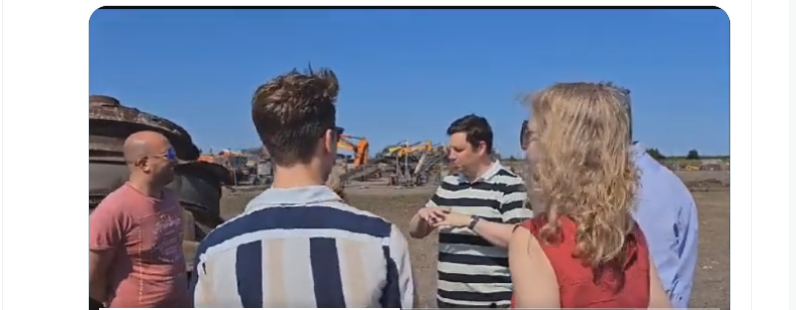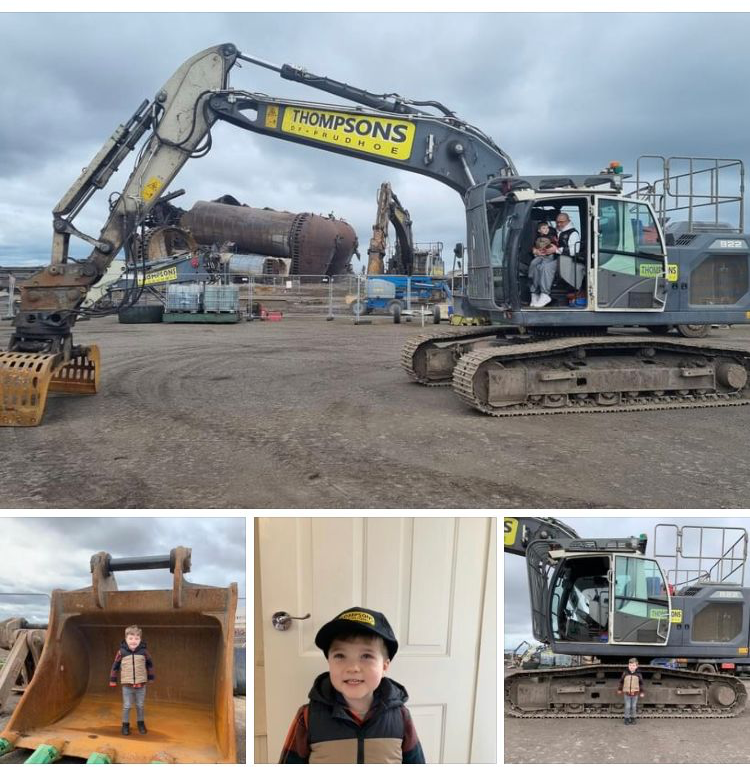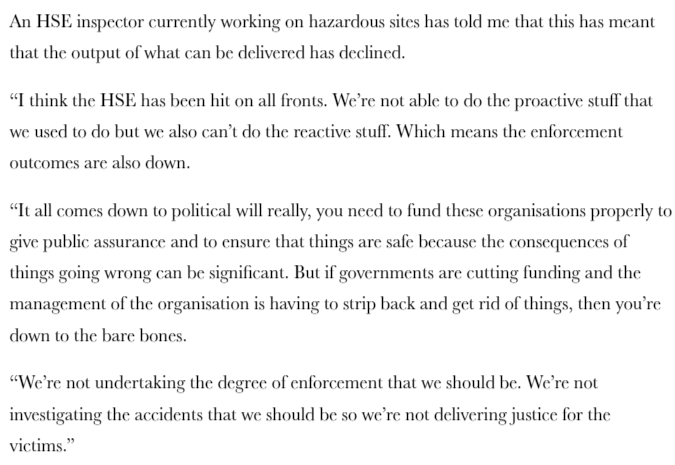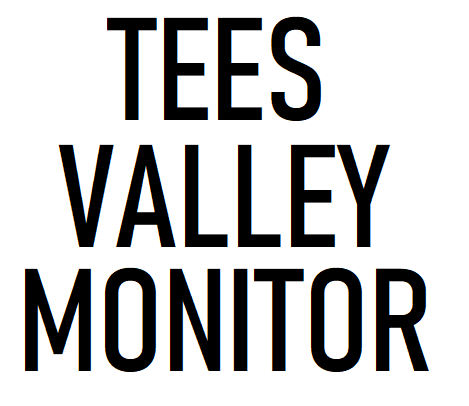Health and Safety
at Work? Not at
Teesworks says
ENDS Report

Redcar and Cleveland Conservative Councillors at Teesworks with TVCA mayor, Ben Houchen, but without PPE
Scott Hunter
14 July 2023
The highly influential ENDS Report [paywall] has revealed serious concerns about the work of safety agencies at the Teesworks site. As this is an issue that Tees Valley Monitor has also extensively covered, we look in detail at the allegations made in the new report.
The report, by news editor, Pippa Neill, begins with an account of the circumstances in which two men – John Mackay and Tommy Williams - died in an explosion at the site. Conversations with the family of one of the victims reveals that the men had little idea of the specific hazards of the job. In the process of preparing ammonia scrubbers for demolition, one of them was using an oxyacetylene torch having been misinformed about the presence of explosive chemicals in the tanks, and investigation is ongoing into who is culpable for this failure.
The matter was first investigated by HSE then turned over to the police/Crown Prosecution Service. Four years on, there is no conclusion in sight. When we contacted John Mackay’s widow, Ann, last week, she informed us that she was waiting for an update from the CPS on the investigation. Fair to say, expectations of significant progress were not high, and the unconscionable delay in providing the families of John Mackay and Tommy Williams with closure has become a scandal in its own right.
The investigation centres on the allegation that the men were told that the well-corroded tanks contained only debris and rainwater, i.e. that no volatile gases remained. The role of Environment Agency in this was to oversee the maintenance of hazardous structures on the site. We should note that there are other hazards on the site (ground contamination, for example) but it was the structures that determined the site’s COMAH status (control of major accident hazards). On site, the maintenance was carried out by workers from the South Tees Site Company – a body set up by the Department for Business (BIS) in 2016 (this company was taken over by STDC in 2020). The work was contracted to the demolition firm JF Hunt. The unanswered question is, where in this chain did the information about the hazard fail to get through?
The ENDS report focuses on the failures of the ‘competent authority’ – the Environment Agency and HSE combined – to properly regulate activity on the site. Thus, in 2018 it removed the requirement for Redcar and Cleveland Council to have an ‘offsite emergency plan’ for the site, which meant that it must have been satisfied that the site had an adequate internal emergency plan in place. This turned out not to be the case (on the day of the accident for example, a gate near the site of the explosion was found to be locked, thus denying access to the emergency services).
A later inspection report from the competent authority, in 2021, points to
“… significant failings in the necessary demonstrations for emergency response arrangements (only two of 11 criteria were met).”
In other words, following the tragedy in 2019, the safety regime at the site then deteriorated. The 2021 report goes on to deem the lack of safety training on site a breach of health and safety law. So, how did it come about that this situation deteriorated, and how did the ‘competent authority’ respond to it?
Pippa Neill discusses the second of these issues at length, but not the first. Of the material in the ‘competent authority’ reports, she says:

Our own view of this deteriorating situation is that it may be connected to the arrival in the intervening period of developers Corney and Musgrave, who were formally installed as joint venture partners in the redevelopment of the site in the summer of 2020. In the autumn of that year also the South Tees Site Company (STSC) came under the control of what was now Teesworks. That company is known to have employed around 120 workers who were responsible for the keepsafe work on the remaining structures on the site. Clearly, by the summer of 2021, they weren’t doing that. So, what was going on?
One of the STSC workers, who spoke to us on condition of anonymity, described an unhappy and demoralized workforce who were no longer able to do the maintenance work that they had been hired by BIS to do. Instead, at the behest of Corney and his son-in-law, Orion Kottri, they were diverted to the task of recovering scrap metal. He reports that this was the only thing they were interested in. The pair were on site all day every day and prevented the workers, to a significant extent, from doing the maintenance job they were properly there to do.
It appears that a lackadaisical attitude to health and safety became customary on the site, as evidenced the recent picture at the top of this article showing Redcar and Cleveland Conservative councillors on a recent visit to the site, none of whom are wearing protective clothing.
Yet more egregious is the example of four-year-old Albie, whose dream came true when Tees Valley mayor, Ben Houchen, arranged for him to visit the site of the Redcar Blast Furnace. Obviously, he didn’t wear PPE for the visit as you don’t get PPE in any sizes that fit four year olds. Obviously, because four year olds are not supposed to be allowed to set foot in places like Teesworks.


There have been a number of accidents on the site, and with them some clumsy attempts at cover up. When, in November 2022, an excavator fell in the river with its driver trapped inside, the first report of the incident was in Tees Valley Monitor (which, in case you hadn’t noticed, does not generally specialize in breaking news). The Gazette followed with an account that was complete fiction. The Echo first reported it about nine days later.
The local press appears to have learned its lesson, however, and the most recent accident – a fire near the now demolished BOS plant – has been reported in the Gazette in good time. However, there remains no confirmation of an alleged incident in early October 2022 when workers on the South Bank Quay suffered asphyxiation after disturbing an underground benzene reservoir.
The timidity of the ‘Competent Authority’
There remains the question of how the HSE, in particular, has dealt with these failings. The ENDS report traces concerns about site safety back as far as 2015. And, more generally, reports on both the HSE and EA having problems retaining and recruiting staff due to the difficulties of providing an adequate level of service within the context of a deregulatory environment. The slashing of budgets for these agencies has been ongoing since 2010. The report quotes two officers, the first from HSE:

The second from EA:

Pippa Neill characterizes this situation as one in which dedicated officers from HSE and EA fight a rearguard action to try to provide the public an adequate level of service while operating in a hostile political environment. To some extent we agree with her evaluation, but not entirely.
Teesworks provides evidence of safety standards being ignored both before and after the arrival of the developers. The mayor’s social media provides instances where safety regulations have been not only flouted but paraded in front of the public. Four years on from the accident that killed Tommy Williams and John Mackay, the investigation has not been concluded and no one has been prosecuted. The ‘competent authority’ is floundering but not moribund.
The fact is that, as statutory services, they will persist regardless of how denuded they are of funds and powers to act. We have reported before our concerns that some of the failure of official oversight at Teesworks is due to its political significance as the flagship of the government’s economic policy, with the implication that there is direct political manipulation of outcomes. Those in government bear ultimate responsibility for that interference in the work of agencies charged with public and environmental safety. But they are not the only ones who bear responsibility.
Government agencies are hierarchies. In a well-functioning agency senior figures not only manage the service but are also its advocates. When a service is allowed to atrophy, as the EA and HSE have done, it is not only the work of front-line staff that becomes difficult to sustain. The work of its senior management also changes, and advocates are replaced by apologists, who defend the indefensible in order to maintain the illusion of service. And thus there is regulation without enforcement; offenders are not prosecuted; the incentive to good practice dissolves; and when there are failures, the buck doesn’t stop, it just disappears.
When the political will to rebuild these services is finally restored, there must be no room for those who have overseen the pretence, who have done the government’s bidding at the expense of the service they are supposed to run, and at the expense of the public they are supposed to protect. Health and safety has truly gone mad.
